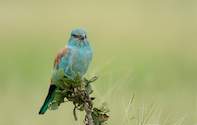
Ornithologists and conservationists are tapping into the skills and enthusiasm of Southern Africa's bird-watchers to collect information about the distribution and relative abundance of its 850 or so bird species.
"SABAP2 builds on the success of SABAP1 SABAP1, which was undertaken from 1987 to 1991", says Doug. "There's an army of enthusiastic bird-watchers out there, eager to add value to their bird-watching", he added.
Some 554 bird-watchers are dedicated to the project. At about 07h23 on Monday 29 June, the one millionth bird observation was submitted to the project. Professor Les Underhill, Director of the Animal Demography Unit (ADU) at the University of Cape Town which is coordinating the project, said: "The 30th June 2009 was the second anniversary of the project, with 780,000 of the million records being submitted in the past 12 months".
SABAP2 is a partnership between the University of Cape Town's Animal Demography Unit (ADU), the South African National Biodiversity Institute (SANBI), and BirdLife South Africa. The ADU provides the technical skills, SANBI provides the financial resources and BirdLife South Africa's members are the 'citizen scientists' who are in the field collecting the data.
SABAP2 uses innovative technologies, where the submission of bird records, the verification of the data, and the subsequent preliminary analyses are all electronic. As a result, the records on the project website (www.sabap2.org) are updated every three hours. This allows the project progress to be monitored and, for example, see how the jigsaw puzzle of pentads (9 x 9 km grid cells) are filled, as atlasers travel to farflung reaches of the country to fulfil their birdwatching passion. So far, 4681 or 27% of the country's pentads have been atlased at least once.
The project's methods are very simple. "One essentially completes a list of the birds seen in the pentad over a minimum of two hours, visiting all the different habitats during that time," said Doug Harebottle. "The listing of the birds in the order in which they were observed allows for a crude estimation of abundance, as common species would generally be recorded first", he explained. The data are then entered into specially developed software, and submitted to the ADU electronically.
Dr Phoebe Barnard at SANBI, chair of the project's steering committee, says "The project has several aims, with one of the most important being to map over a fine scale the distribution of South Africa's birds". "This information will allow us to make comparisons over time, especially to determine climate change effects on bird distributions and to allow for fine-scale conservation planning.
A total of 125 of our birds are threatened and listed in the Red Data Book, so it is also important to monitor changes in their distribution and numbers". We need to know whether their numbers and ranges continue to decline, and whether or not our conservation interventions are effective.
"BirdLife South Africa's members are very involved in this project", says Mark Anderson, executive director of BirdLife South Africa. "Some of our members have become very passionate about SABAP2 and their contributions to the project and ultimately to bird conservation are invaluable. It would be impossible to employ professional ornithologists to achieve the results of these 'citizen scientists'.
The millionth record was recorded by atlaser Christopher Patton, that of a Whitebacked Vulture, ironically a species predicted to be negatively affected by climate and land-use change.
Dateline: 2011
Visit Birding in Kruger Park for more info on the best birding routes in Kruger national Park.

